Freezing Fog Microphysics and Visibility Based on CFACT Feb 19 Case
Abstract
1. Introduction
2. Field Campaign and Observations
2.1. Project Location and Observations
2.2. Synoptic Weather Systems
2.3. Observations
3. Method
3.1. Aerosol Composition Impact on Droplet Size
3.2. Droplet Growth During Freezing Fog Event
3.3. Freezing Droplet Effect on Extinction Coefficient
3.4. Microphysical Parameterizations
4. Results
4.1. Time Series of Microphysical Parameters
4.2. Aerosol Chemical and Physical Effects on Visibility
4.3. Aerosol Composition Effect on Droplet Growth
4.4. Freezing Fog and Density Effects on Vis
4.5. Visibility Parameterization
5. Discussion
5.1. Freezing Droplet Size Effect on Vis Calculations
5.2. Uncertainty in Measurement of Microphysical Parameters
5.3. FM120 and PWD Vis Comparison
5.4. Visibility Comparisons Using Observations and Parameterizations
6. Conclusions
- Synoptic weather conditions are found to affect local fog conditions and colder temperature advection likely created instability for FFG formation over the complex terrain. Moving an HP system over the project area (e.g., Heber Valley) was a reason for FFG formation.
- Freezing fog can occur at temperatures as low as −10 °C when IR cooling at night happens.
- Freezing fog dissipation is initiated after sunrise with increasing SW radiative heating.
- Aerosol composition effect on Vis can be significant and can reach up to 1000 m at low LWC values, and droplet size can increase up to 2 µm affecting Vis.
- Aerosols had an occurrence of 54.7.3% based on Teflon filter observation and were not included in the analysis. Only inorganic components are considered based on availability of the observations. Among the inorganic components, soil-based aerosols accounted for 8.9%, NaCl for 10.6%, NH4NO3 for 18.6%, and (NH4)2SO4 for 7.2%.
- Freezing droplet density with riming can be an important factor reducing Vis down to at least 50% but freezing fog density can affect Vis at about 10% during FFG event.
- Differences in Vis parameterizations suggest that FFG and WFG conditions can be different, and this can be more than 50% when the crystal shape and density change significantly.
- Large differences between PWD Vis and FM120 Vis can be significant and reach up to 1 km, and that needs to be further researched.
Author Contributions
Funding
Data Availability Statement
Conflicts of Interest
Abbreviations
| ABL | Atmospheric boundary layer |
| a.g.l. | Above ground level |
| AI | Artificial intelligence |
| C | Brightness contrast threshold |
| CCN | Cloud condensation nuclei |
| CL31h | The horizontal looking CL31 ceilometer |
| CFACT | Cold Fog Amongst Complex Terrain |
| D | Diameter of droplet |
| DC AT | Deer Creek Aerosol Trailer |
| DC FT | Deer Creek Flux Tower |
| DC MP | Deer Creek Microphysics supersite |
| DC SS | Deer Creek Supersite |
| DSD | Droplet size distribution |
| Dv | Water vapor diffusion coefficient in air |
| EOL | Earth Observing Laboratory |
| e*(r) | Equilibrium vapor pressure over a solution droplet |
| es | Saturated water vapor pressure |
| es,w (∞) | Saturated water vapor pressure over a flat pure water surface |
| FFG | Freezing fog |
| FI | Fog index |
| FM120 | Fog monitor model FM-120 |
| GCIP | Ground cloud imaging probe |
| GFS | Global Forecast Model |
| GOES | Geostationary Operational Environmental Satellites |
| HP | High-pressure |
| i | Van’t Hoff factor |
| IFG | Ice fog |
| IMPROVE | Interagency Monitoring of Protected Visual Environement |
| IN | Ice nuclei |
| IOP | Intensive Observation Period |
| IR | Infrared |
| IWC | Ice water content |
| K | Thermal conductivity coefficient |
| LANFEX | The Local and Non-local Fog Experiment |
| LAOF | Lower Atmospheric Observing Facilities |
| LDR | Linear depolarization ratio |
| Lv | Latent heat of vaporization |
| LWC | Liquid Water Content |
| m | Number of particle spectral bins |
| MATERHORN | Mountain Terrain Atmospheric Modeling and Observations |
| MAE | Mean Absolute Error |
| mi | Ice crystal mass |
| MP | Microphysical |
| Ms | Molecular weight of solute |
| ms | Solute mass |
| MSL | Mean sea level |
| MTAS | MiniVol tactical air sampler |
| MVD | Mean volume diameter |
| MVDice | Mean volume diameter for ice crystals |
| MVDliq | Mean volume diameter for liquid droplets |
| mw | Water mass |
| n(r) | Particle number concentration with radius r |
| NaCl | Sodium chloride |
| Nal | Large aerosols particles |
| Nas | Small aerosols particles |
| Na | Aerosol number concentration |
| NCAR | National Center for Atmospheric Research |
| Nd | Droplet number concentration |
| NH4NO3 | Ammonium Nitrate |
| (NH4)2SO4 | Ammonium Sulfate |
| Ni | Ice crystal number concentration |
| NSF | National Science Foundation |
| NWP | Numerical weather prediction |
| OntTecU | Ontario Technical University |
| P0 | Surface pressure |
| PM10 | Particular matter with diameter < 10 micrometer |
| PR | Precipitation rate |
| PWD22 | Present weather detector and visibility sensor model 22 |
| qv | Vapor mixing ratio |
| Qeff | Extinction efficiency |
| R | Universal gas constant |
| r | Droplet radius |
| r2 | Spherical particle cross-sectional area when multiplied by π |
| rc | Critical radius |
| rdry | Dry radius |
| reff | Effective radius |
| RHw | Relative Humidity with respect to water |
| RID | Rosemount Icing Detector |
| ri | Freezing droplet radius when assume as ice |
| Rv | Specific gas constant of water vapor |
| rw | Liquid droplet radius |
| S | Saturation ratio with respect to water |
| s | Supersaturation |
| Sc | Critical saturation ratio |
| Sd | Standard deviation |
| SDs | Supercooled droplets |
| SMPS | Scanning mobility particle sizer |
| SW | Shortwave |
| SWIR | Shortwave infrared |
| SWRF | Short wave radiative flux |
| T0 | Surface air temperature |
| Ta | Air temperature |
| TAS | True air speed |
| Td | Dew point temperature |
| TPWD | Temperature at the PWD inlet |
| Uh | Wind speed |
| UU | University of Utah |
| Vis | Visibility |
| Visice | Visibility for ice crystals |
| Visliq | Visibility for liquid droplets |
| Vs | Volume of the dry particulate matter |
| Vw | Volume of the water |
| WFG | Warm fog |
| WRF | Weather Research and Forecast Model |
| β | Backscatter coefficient |
| βext | Extinction coefficient |
| βh | Horizontal backscattering ratio |
| Δr | Difference between freezing droplet radius and liquid droplet radius |
| ρi | Density of ice |
| ρl | Density of water droplet |
| ρw | Density of water |
| σw | Surface tension of water in the air |
| κ | Particle hygroscopicity (Kappa) parameter |
References
- AMS (American Meteorological Society). Glossary of Meteorology; AMS: Amsterdam, The Netherlands, 2024; Available online: https://glossary.ametsoc.org (accessed on 14 June 2025).
- Gultepe, I.; Pearson, G.; Milbrandt, J.A.; Hansen, B.; Platnick, S.; Taylor, P.; Gordon, M.; Oakley, J.P.; Cober, S.G. The Fog Remote Sensing and Modeling Field Project. Bull. Amer. Meteor. Soc. 2009, 90, 341–360. [Google Scholar] [CrossRef]
- Gultepe, I.; Heymsfield, A.J.; Gallagher, M. Arctic Ice Fog: Its Microphysics and Prediction. In Physics and Chemistry of the Arctic Atmosphere; Kokhanovsky, A., Tomasi, C., Eds.; Springer Polar Sciences; Springer International Publishing: Cham, Switzerland, 2020; pp. 361–414. ISBN 978-3-030-33565-6. [Google Scholar]
- Heymsfield, A.J.; Sabin, R.M. Cirrus Crystal Nucleation by Homogeneous Freezing of Solution Droplets. J. Atmos. Sci. 1989, 46, 2252–2264. [Google Scholar] [CrossRef]
- Sassen, K.; Dodd, G.C. Homogeneous Nucleation Rate for Highly Supercooled Cirrus Cloud Droplets. J. Atmos. Sci. 1988, 45, 1357–1369. [Google Scholar] [CrossRef]
- Gultepe, I.; Heymsfield, A.J.; Gallagher, M.; Ickes, L.; Baumgardner, D. Ice Fog: The Current State of Knowledge and Future Challenges. Meteorol. Monogr. 2017, 58, 4.1–4.24. [Google Scholar] [CrossRef]
- Pu, Z.; Pardyjak, E.R.; Hoch, S.W.; Gultepe, I.; Hallar, A.G.; Perelet, A.; Beal, R.; Carrillo-Cardenas, G.; Li, X.; Garcia, M.; et al. Cold Fog Amongst Complex Terrain. Bull. Am. Meteorol. Soc. 2023, 104, E2030–E2052. [Google Scholar] [CrossRef]
- Noonkester, V.R. Coastal Marine Fog in Southern California. Mon. Weather Rev. 1979, 107, 830–851. [Google Scholar] [CrossRef]
- Leipper, D.F. Fog on the U.S. West Coast: A Review. Bull. Amer. Meteor. Soc. 1994, 75, 229–240. [Google Scholar] [CrossRef]
- Kloesel, K.A. A 70-Year History of Marine Stratocumulus Cloud Field Experiments off the Coast of California. Bull. Amer. Meteor. Soc. 1992, 73, 1581–1585. [Google Scholar] [CrossRef]
- Gultepe, I.; Milbrandt, J.A. Probabilistic Parameterizations of Visibility Using Observations of Rain Precipitation Rate, Relative Humidity, and Visibility. J. Appl. Meteorol. Climatol. 2010, 49, 36–46. [Google Scholar] [CrossRef]
- Gultepe, I.; Zhou, B.; Milbrandt, J.; Bott, A.; Li, Y.; Heymsfield, A.J.; Ferrier, B.; Ware, R.; Pavolonis, M.; Kuhn, T.; et al. A Review on Ice Fog Measurements and Modeling. Atmos. Res. 2015, 151, 2–19. [Google Scholar] [CrossRef]
- Lareau, N.P.; Crosman, E.; Whiteman, C.D.; Horel, J.D.; Hoch, S.W.; Brown, W.O.J.; Horst, T.W. The Persistent Cold-Air Pool Study. Bull. Am. Meteorol. Soc. 2013, 94, 51–63. [Google Scholar] [CrossRef]
- Paci, A.; Staquet, C.; Allard, J.; Barral, H.; Canut, G.; Cohard, J.-M.; Jaffrezo, J.-L.; Martinet, P.; Sabatier, T.; Troude, F.; et al. La Campagne Passy-2015: Dynamique Atmosphérique et Qualité de l’air Dans La Vallée de l’Arve. Pollut. Atmos. 2016, 231–232. [Google Scholar] [CrossRef]
- Price, J.D.; Lane, S.; Boutle, I.A.; Smith, D.K.E.; Bergot, T.; Lac, C.; Duconge, L.; McGregor, J.; Kerr-Munslow, A.; Pickering, M.; et al. LANFEX: A Field and Modeling Study to Improve Our Understanding and Forecasting of Radiation Fog. Bull. Am. Meteorol. Soc. 2018, 99, 2061–2077. [Google Scholar] [CrossRef]
- Fernando, H.J.S.; Pardyjak, E.R.; Di Sabatino, S.; Chow, F.K.; De Wekker, S.F.J.; Hoch, S.W.; Hacker, J.; Pace, J.C.; Pratt, T.; Pu, Z.; et al. The MATERHORN: Unraveling the Intricacies of Mountain Weather. Bull. Am. Meteorol. Soc. 2015, 96, 1945–1967. [Google Scholar] [CrossRef]
- Gultepe, I.; Fernando, H.J.S.; Pardyjak, E.R.; Hoch, S.W.; Silver, Z.; Creegan, E.; Leo, L.S.; Pu, Z.; De Wekker, S.F.J.; Hang, C. An Overview of the MATERHORN Fog Project: Observations and Predictability. Pure Appl. Geophys. 2016, 173, 2983–3010. [Google Scholar] [CrossRef]
- Gultepe, I.; Kuhn, T.; Pavolonis, M.; Calvert, C.; Gurka, J.; Heymsfield, A.J.; Liu, P.S.K.; Zhou, B.; Ware, R.; Ferrier, B.; et al. Ice Fog in Arctic During FRAM–Ice Fog Project: Aviation and Nowcasting Applications. Bull. Am. Meteorol. Soc. 2014, 95, 211–226. [Google Scholar] [CrossRef]
- Gultepe, I.; Isaac, G.A.; Rasmussen, R.M.; Ungar, K. A Freezing Fog/Drizzle Event during the FRAM-S Project. In Proceedings of the SAE 2011 International Conference on Aircraft and Engine Icing and Ground Deicing, Chicago, IL, USA, 13–17 June 2011. SAE Technical Paper 2011-38-0028. [Google Scholar]
- Ghude, S.D.; Bhat, G.S.; Prabhakaran, T.; Jenamani, R.K.; Chate, D.M.; Safai, P.D.; Karipot, A.K.; Konwar, M.; Pithani, P.; Sinha, V.; et al. Winter Fog Experiment Over the Indo-Gangetic Plains of India. Curr. Sci. 2017, 112, 767. [Google Scholar] [CrossRef]
- Pithani, P.; Ghude, S.D.; Jenamani, R.K.; Biswas, M.; Naidu, C.V.; Debnath, S.; Kulkarni, R.; Dhangar, N.G.; Jena, C.; Hazra, A.; et al. Real-Time Forecast of Dense Fog Events over Delhi: The Performance of the WRF Model during the WiFEX Field Campaign. Weather Forecast. 2020, 35, 739–756. [Google Scholar] [CrossRef]
- Zhou, B.; Ferrier, B.S. Asymptotic Analysis of Equilibrium in Radiation Fog. J. Appl. Meteorol. Climatol. 2008, 47, 1704–1722. [Google Scholar] [CrossRef]
- Price, J.D. On the Formation and Development of Radiation Fog: An Observational Study. Bound.-Layer Meteorol. 2019, 172, 167–197. [Google Scholar] [CrossRef]
- Gultepe, I.; Heymsfield, A.J.; Fernando, H.J.S.; Pardyjak, E.; Dorman, C.E.; Wang, Q.; Creegan, E.; Hoch, S.W.; Flagg, D.D.; Yamaguchi, R.; et al. A Review of Coastal Fog Microphysics During C-FOG. Bound.-Layer Meteorol. 2021, 181, 227–265. [Google Scholar] [CrossRef]
- Mazoyer, M.; Burnet, F.; Denjean, C. Experimental Study on the Evolution of Droplet Size Distribution during the Fog Life Cycle. Atmos. Chem. Phys. 2022, 22, 11305–11321. [Google Scholar] [CrossRef]
- Hang, C.; Nadeau, D.F.; Gultepe, I.; Hoch, S.W.; Román-Cascón, C.; Pryor, K.; Fernando, H.J.S.; Creegan, E.D.; Leo, L.S.; Silver, Z.; et al. A Case Study of the Mechanisms Modulating the Evolution of Valley Fog. Pure Appl. Geophys. 2016, 173, 3011–3030. [Google Scholar] [CrossRef]
- Beal, R.L.; Pu, Z.; Pardyjak, E.; Hoch, S.; Gultepe, I. Evaluation of Near-surface and Boundary-layer Meteorological Conditions That Support Cold-fog Formation Using Cold Fog Amongst Complex Terrain Field Campaign Observations. Q. J. R. Meteorol. Soc. 2024, 150, 4329–4347. [Google Scholar] [CrossRef]
- Schwenkel, J.; Maronga, B. Large-Eddy Simulation of Radiation Fog with Comprehensive Two-Moment Bulk Microphysics: Impact of Different Aerosol Activation and Condensation Parameterizations. Atmos. Chem. Phys. 2019, 19, 7165–7181. [Google Scholar] [CrossRef]
- Gultepe, I.; Pagowski, M.; Milbrandt, J. A new visibility parameterization for warm-fog applications in numerical weather prediction models. J. Appl. Meteorol. 2005, 44, 1296–1306. [Google Scholar] [CrossRef]
- Gultepe, I.; Pagowski, M.; Reid, J. A Satellite-Based Fog Detection Scheme Using Screen Air Temperature. Weather Forecast. 2007, 22, 444–456. [Google Scholar] [CrossRef]
- Kunkel, B.A. Parameterization of Droplet Terminal Velocity and Extinction Coefficient in Fog Models. J. Climate Appl. Meteor. 1984, 23, 34–41. [Google Scholar] [CrossRef]
- Stoelinga, M.T.; Warner, T.T. Nonhydrostatic, Mesobeta-Scale Model Simulations of Cloud Ceiling and Visibility for an East Coast Winter Precipitation Event. J. Appl. Meteor. 1999, 38, 385–404. [Google Scholar] [CrossRef]
- Gultepe, I.; Tardif, R.; Michaelides, S.C.; Cermak, J.; Bott, A.; Bendix, J.; Müller, M.D.; Pagowski, M.; Hansen, B.; Ellrod, G.; et al. Fog Research: A Review of Past Achievements and Future Perspectives. Pure Appl. Geophys. 2007, 164, 1121–1159. [Google Scholar] [CrossRef]
- Gultepe, I.; Milbrandt, J.A.; Zhou, B. Marine Fog: A Review on Microphysics and Visibility Prediction. In Marine Fog: Challenges and Advancements in Observations, Modeling, and Forecasting; Koračin, D., Dorman, C.E., Eds.; Springer Atmospheric Sciences; Springer International Publishing: Cham, Switzerland, 2017; pp. 345–394. ISBN 978-3-319-45227-2. [Google Scholar]
- Lin, C.; Zhang, Z.; Pu, Z.; Wang, F. Numerical Simulations of an Advection Fog Event over Shanghai Pudong International Airport with the WRF Model. J. Meteorol. Res. 2017, 31, 874–889. [Google Scholar] [CrossRef]
- Pu, Z.; Chachere, C.N.; Hoch, S.W.; Pardyjak, E.; Gultepe, I. Numerical Prediction of Cold Season Fog Events over Complex Terrain: The Performance of the WRF Model During MATERHORN-Fog and Early Evaluation. Pure Appl. Geophys. 2016, 173, 3165–3186. [Google Scholar] [CrossRef]
- Chachere, C.N.; Pu, Z. Numerical Simulations of an Inversion Fog Event in the Salt Lake Valley during the MATERHORN-Fog Field Campaign. Pure Appl. Geophys. 2019, 176, 2139–2164. [Google Scholar] [CrossRef]
- Carrillo-Cardenas, G.; Hoch, S.W.; Pardyjak, E.; Garcia, M.; Brown, W.; Pu, Z.; Hallar, A.G. Elucidating New Particle Formation in Complex Terrain During the Winter 2022 Cold Fog Amongst Complex Terrain (CFACT) Campaign. JGR Atmos. 2025, 130, e2024JD042307. [Google Scholar] [CrossRef]
- Chachere, C.N.; Pu, Z. Connections Between Cold Air Pools and Mountain Valley Fog Events in Salt Lake City. Pure Appl. Geophys. 2016, 173, 3187–3196. [Google Scholar] [CrossRef]
- Pruppacher, H.R.; Klett, J.D. Microphysics of Clouds and Precipitation; Springer: Dordrecht, The Netherlands, 1978; ISBN 978-90-277-1106-9. [Google Scholar]
- Petters, M.D.; Kreidenweis, S.M. A Single Parameter Representation of Hygroscopic Growth and Cloud Condensation Nucleus Activity. Atmos. Chem. Phys. 2007, 7, 1961–1971. [Google Scholar] [CrossRef]
- Chow, J.C.; Lowenthal, D.H.; Chen, L.-W.A.; Wang, X.; Watson, J.G. Mass Reconstruction Methods for PM2.5: A Review. Air Qual. Atmos. Health 2015, 8, 243–263. [Google Scholar] [CrossRef]
- Beard, K.V.; Pruppacher, H.R. A Wind Tunnel Investigation of the Rate of Evaporation of Small Water Drops Falling at Terminal Velocity in Air. J. Atmos. Sci. 1971, 28, 1455–1464. [Google Scholar] [CrossRef]
- Koschmieder, H. Theorie der horizontalen Sichtweite. Beiträge Physik Freien Atmosphäre 1924, 12, 33–55. [Google Scholar]
- Girard, E.; Blanchet, J.-P. Simulation of Arctic Diamond Dust, Ice Fog, and Thin Stratus Using an Explicit Aerosol–Cloud–Radiation Model. J. Atmos. Sci. 2001, 58, 1199–1221. [Google Scholar] [CrossRef]
- Girard, E.; Dueymes, G.; Du, P.; Bertram, A.K. Assessment of the Effects of Acid-coated Ice Nuclei on the Arctic Cloud Microstructure, Atmospheric Dehydration, Radiation and Temperature during Winter. Int. J. Climatol. 2013, 33, 599–614. [Google Scholar] [CrossRef]
- Lohmann, U.; Lüönd, F.; Mahrt, F. An Introduction to Clouds: From the Microscale to Climate, 1st ed.; Cambridge University Press: Cambridge, UK, 2016; ISBN 978-1-107-01822-8. [Google Scholar]
- Gultepe, I.; Isaac, G.A. Aircraft Observations of Cloud Droplet Number Concentration: Implications for Climate Studies. Q. J. R. Meteorol. Soc. 2004, 130, 2377–2390. [Google Scholar] [CrossRef]
- Toth, G.; Gultepe, I.; Milbrandt, J.; Hansen, B.; Pearson, G.; Fogarty, C.; Burrows, W. The Environment Canada Handbook on Fog and Fog Forecasting; Environment Canada: Gatineau, QC, Canada, 2010; ISBN 978-1-100-52518-1. [Google Scholar]
- Zhou, B.; Du, J. Fog Prediction from a Multimodel Mesoscale Ensemble Prediction System. Weather Forecast. 2010, 25, 303–322. [Google Scholar] [CrossRef]
- Claxton, B.M. Using a Neural Network to Benchmark a Diagnostic Parametrization: The Met Office’s Visibility Scheme. Q. J. R. Meteorol. Soc. 2008, 134, 1527–1537. [Google Scholar] [CrossRef]
- Miao, Y.; Potts, R.; Huang, X.; Elliott, G.; Rivett, R. A Fuzzy Logic Fog Forecasting Model for Perth Airport. Pure Appl. Geophys. 2012, 169, 1107–1119. [Google Scholar] [CrossRef]
- Bott, A.; Sievers, U.; Zdunkowski, W. A Radiation Fog Model with a Detailed Treatment of the Interaction between Radiative Transfer and Fog Microphysics. J. Atmos. Sci. 1990, 47, 2153–2166. [Google Scholar] [CrossRef]
- Bott, A.; Trautmann, T. PAFOG—A New Efficient Forecast Model of Radiation Fog and Low-Level Stratiform Clouds. Atmos. Res. 2002, 64, 191–203. [Google Scholar] [CrossRef]
- Golding, B.W. A Study of the Influence of Terrain on Fog Development. Mon. Weather Rev. 1993, 121, 2529–2541. [Google Scholar] [CrossRef]
- Haiden, T.; Kann, A.; Pistotnik, G. Nowcasting with INCA During SNOW-V10. Pure Appl. Geophys. 2014, 171, 231–242. [Google Scholar] [CrossRef]
- Gultepe, E.; Wang, S.; Blomquist, B.; Fernando, H.J.S.; Kreidl, O.P.; Delene, D.J.; Gultepe, I. Machine Learning Analysis and Nowcasting of Marine Fog Visibility Using FATIMA Grand Banks Campaign Measurements. Front. Earth Sci. 2024, 11, 1321422. [Google Scholar] [CrossRef]
- Fernandez, D.; Kim, S.; Robinson, T. Standard Fog Collector and Dual FM-120 Comparisons. Atmos. Res. 2025, 315, 107869. [Google Scholar] [CrossRef]
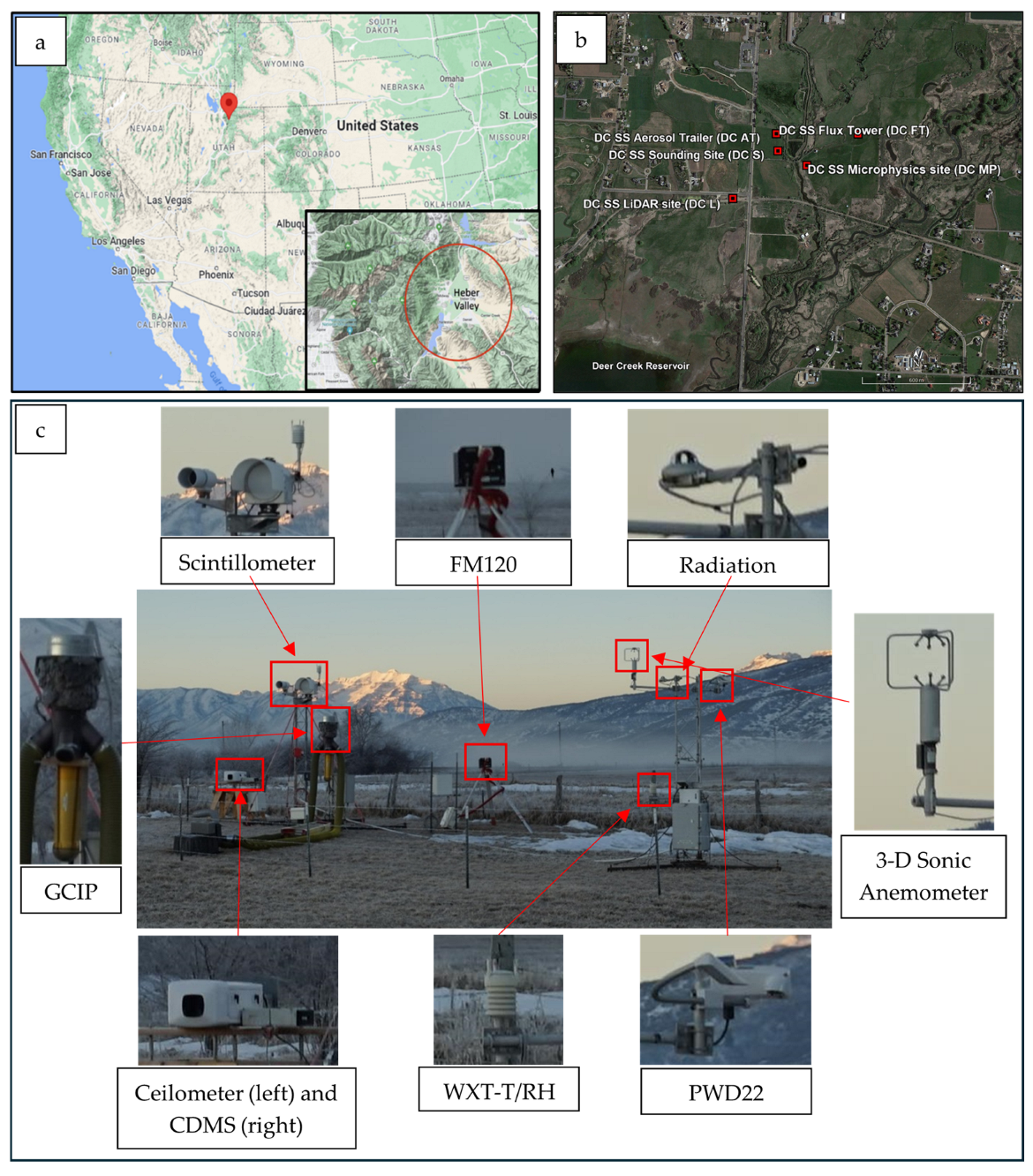
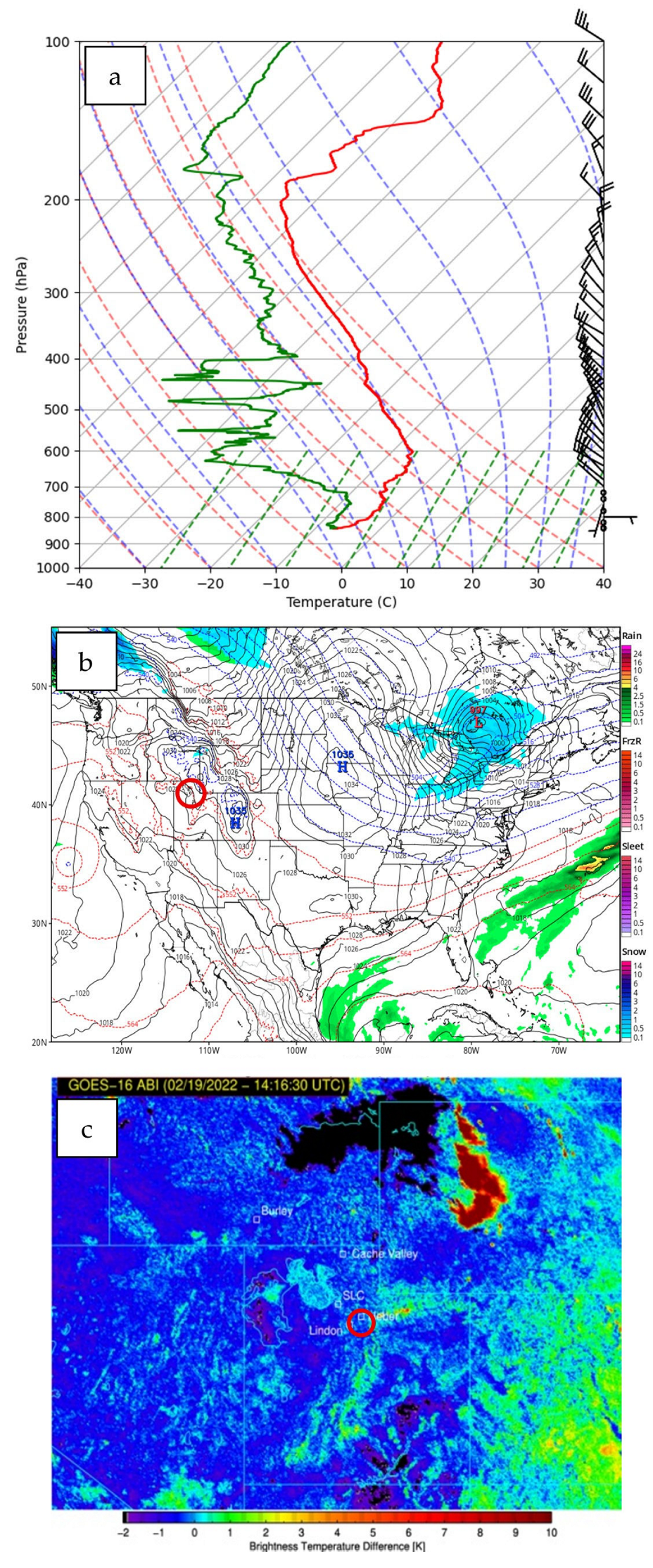
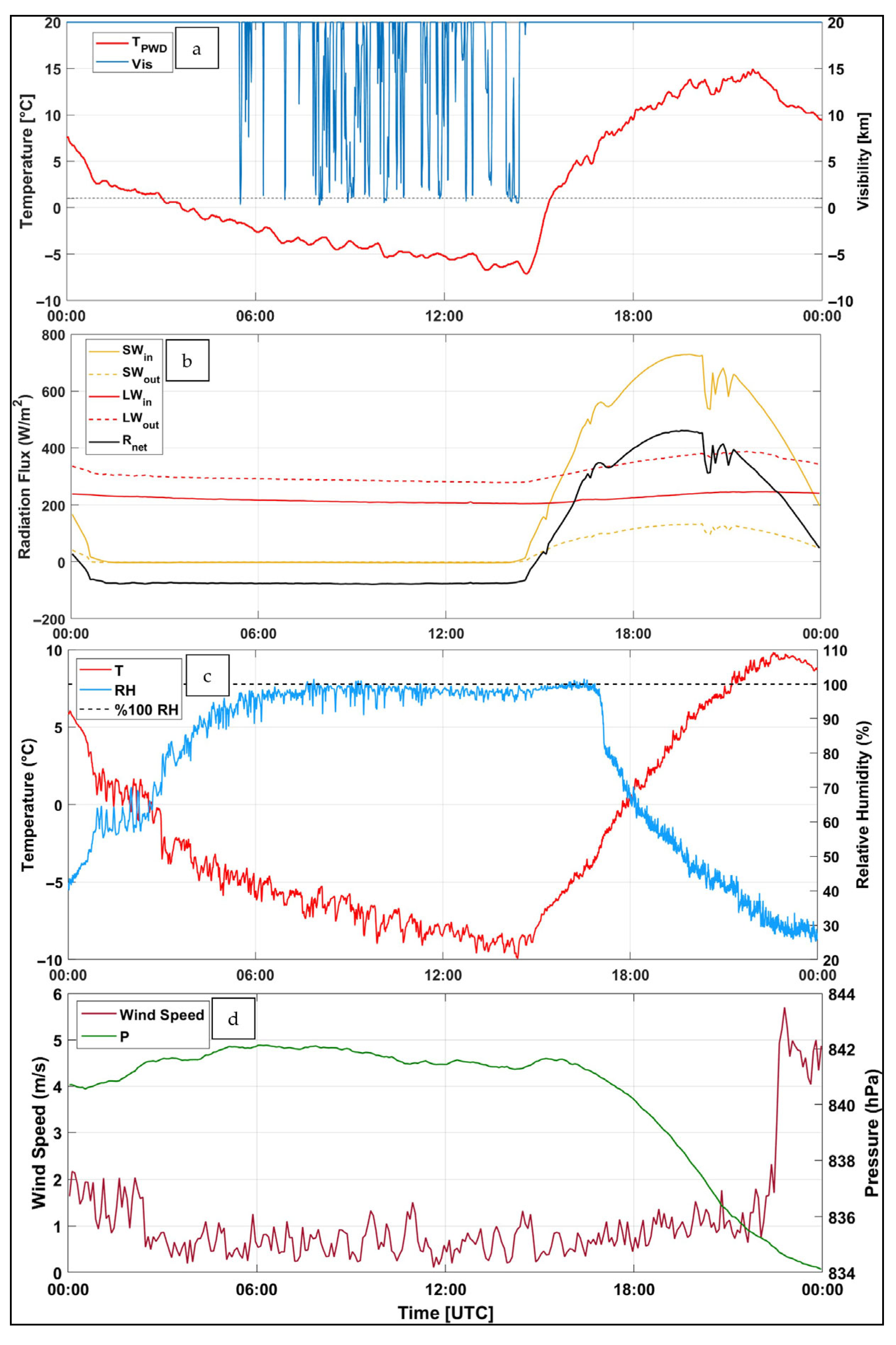

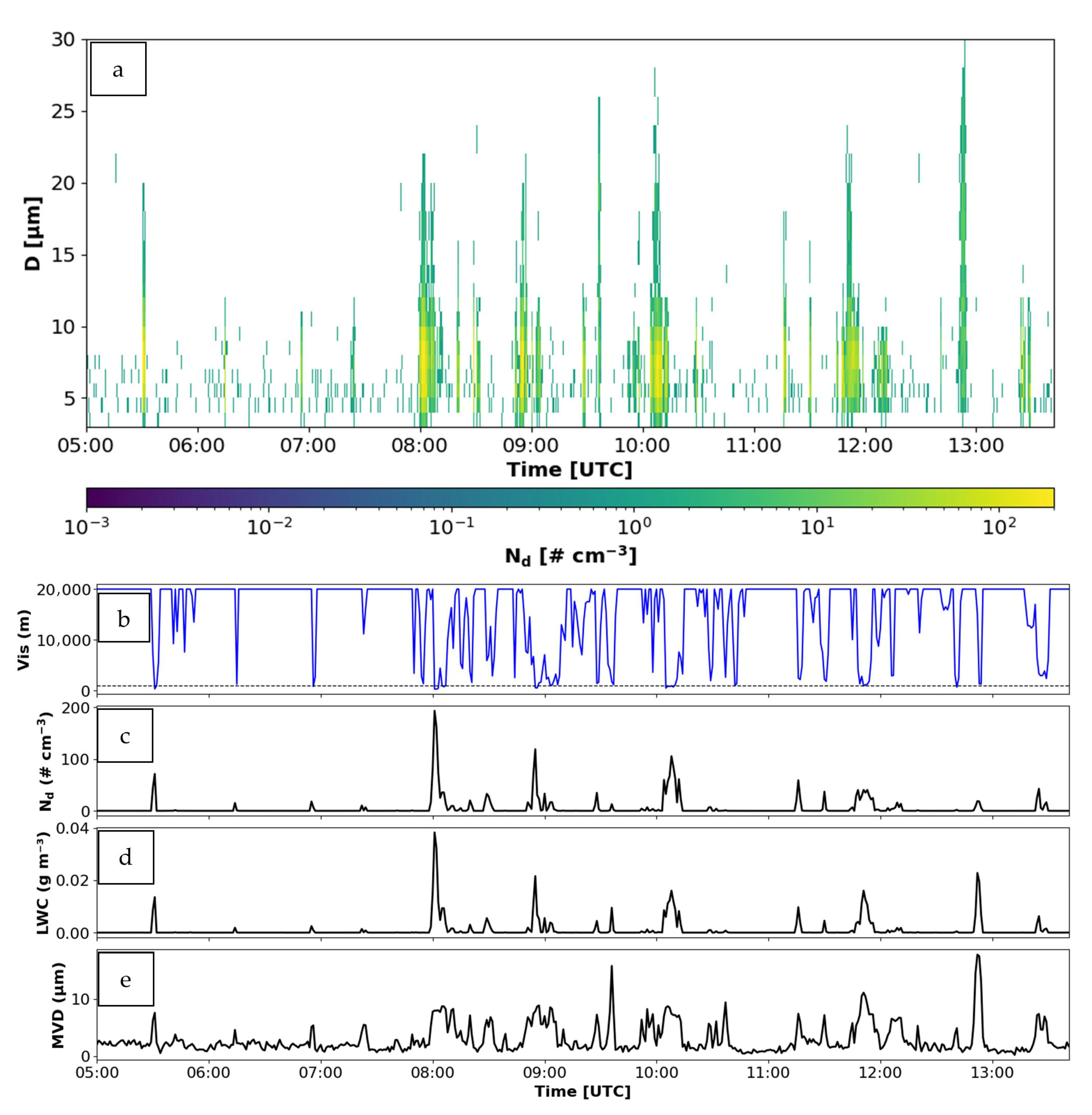
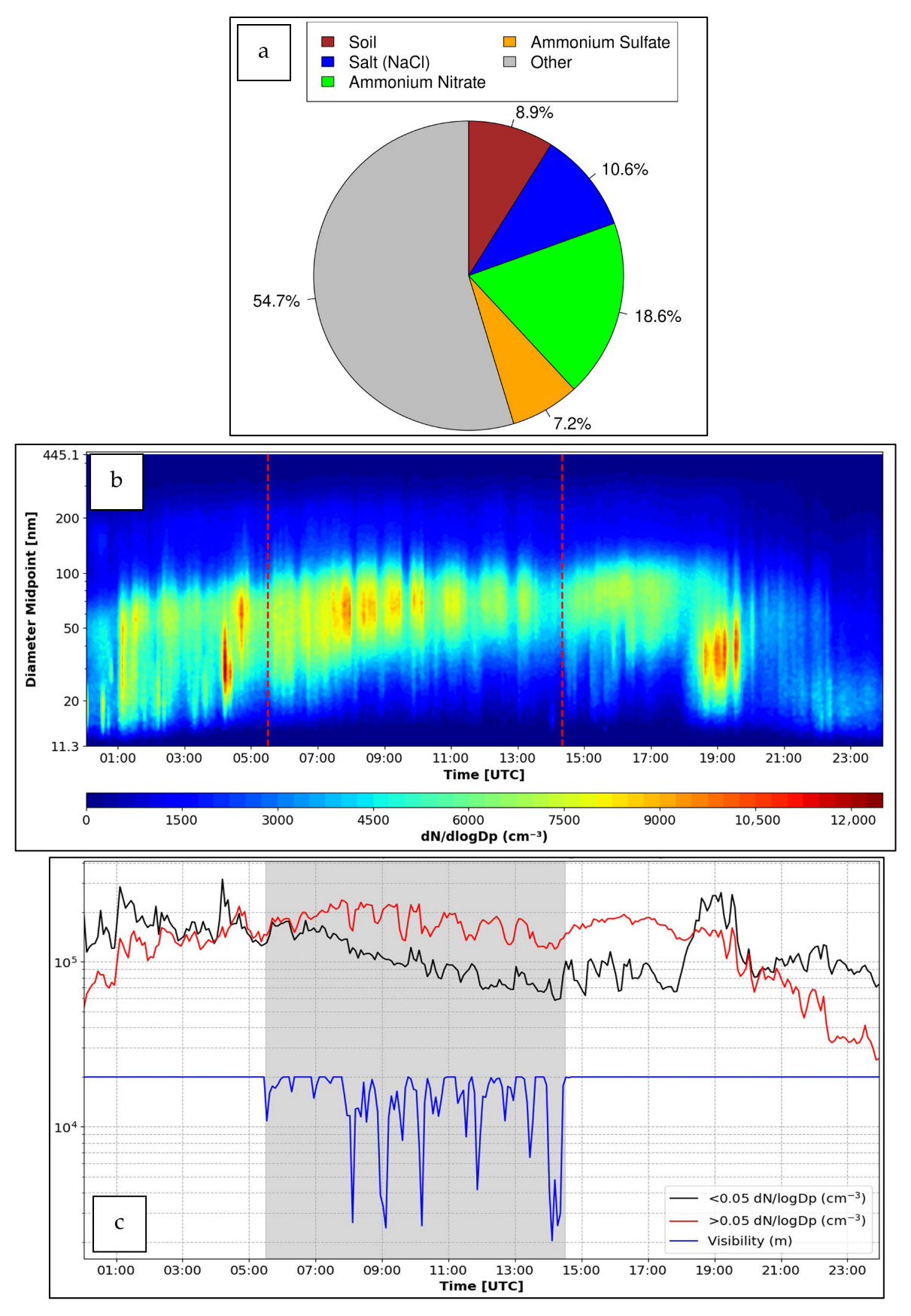

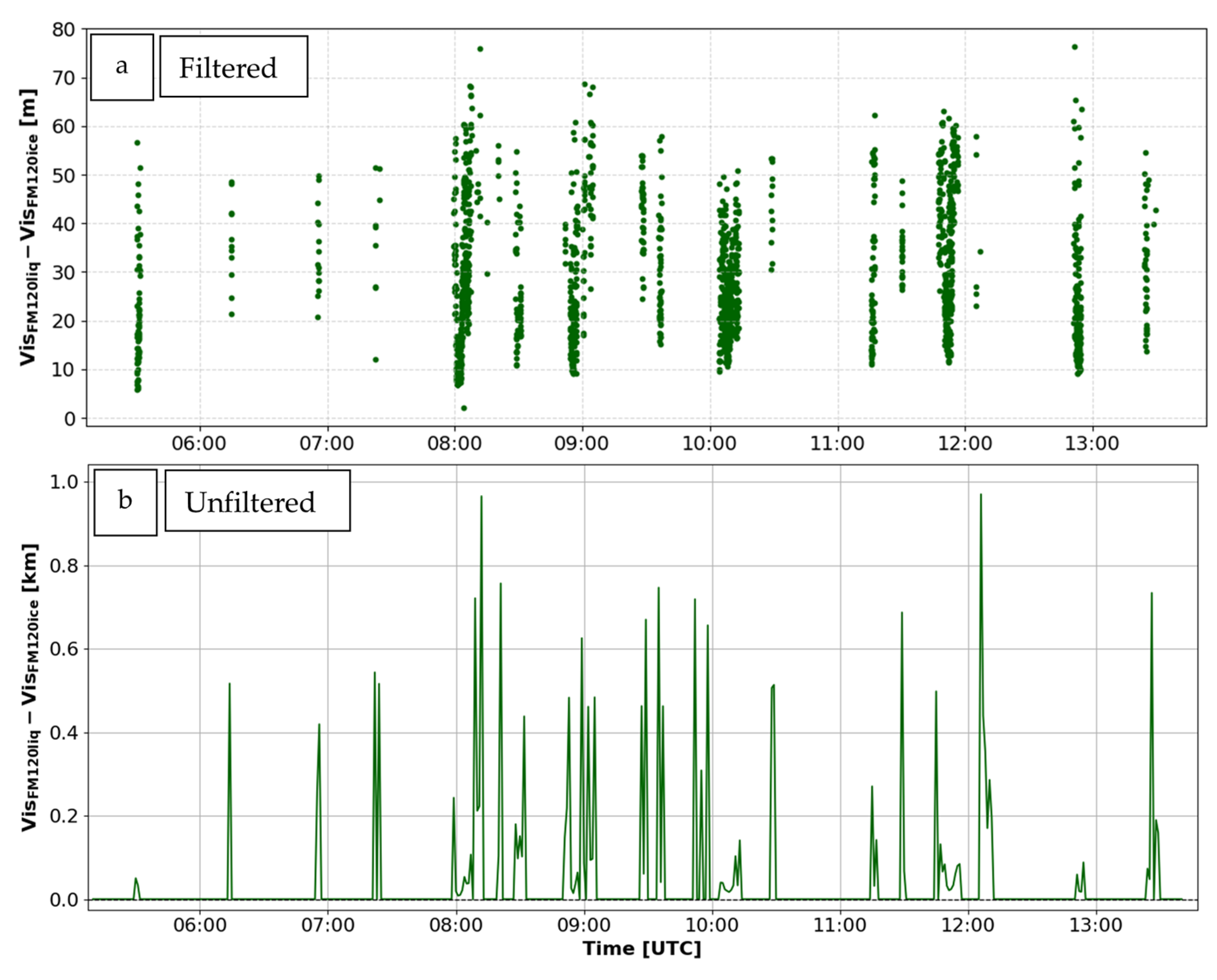
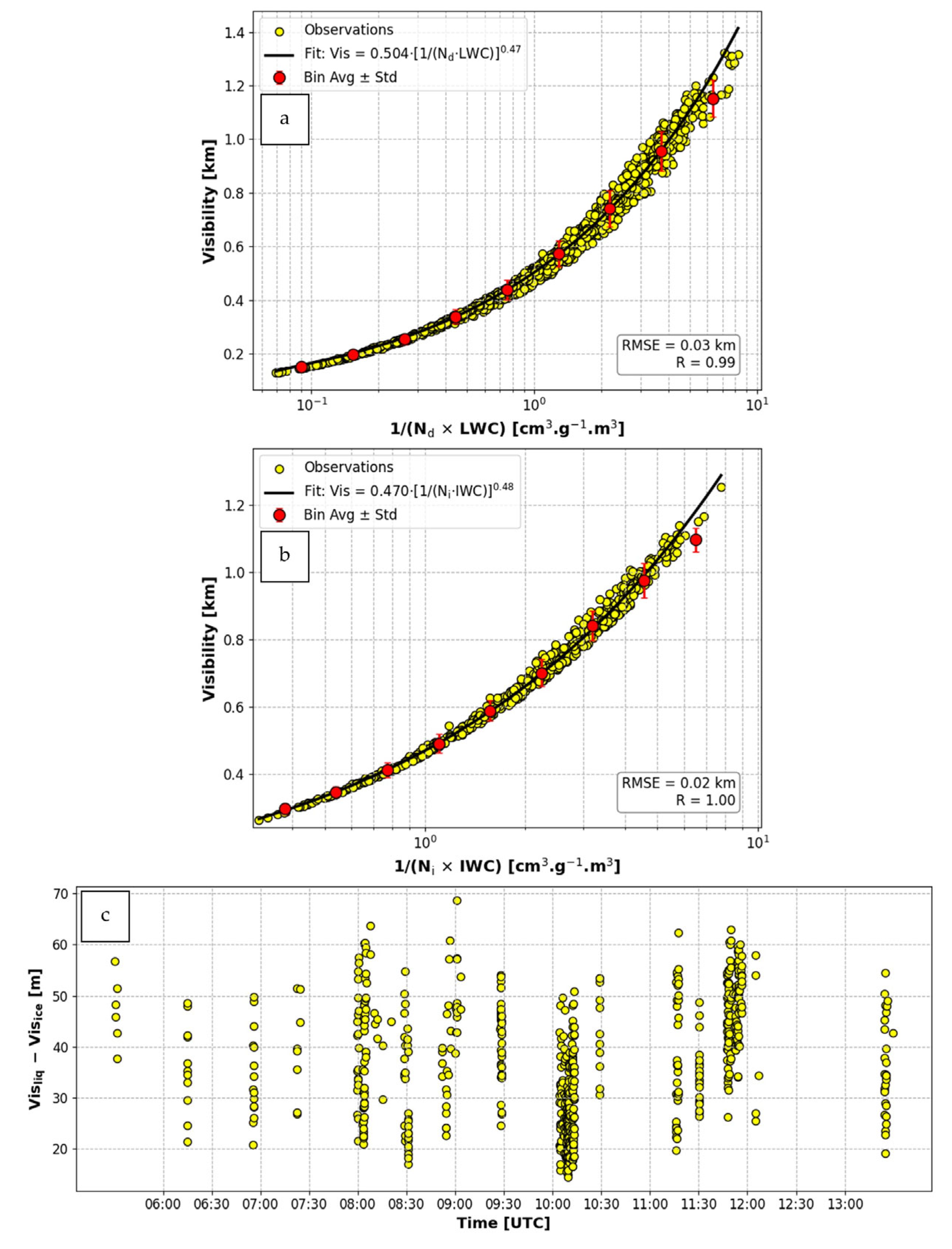
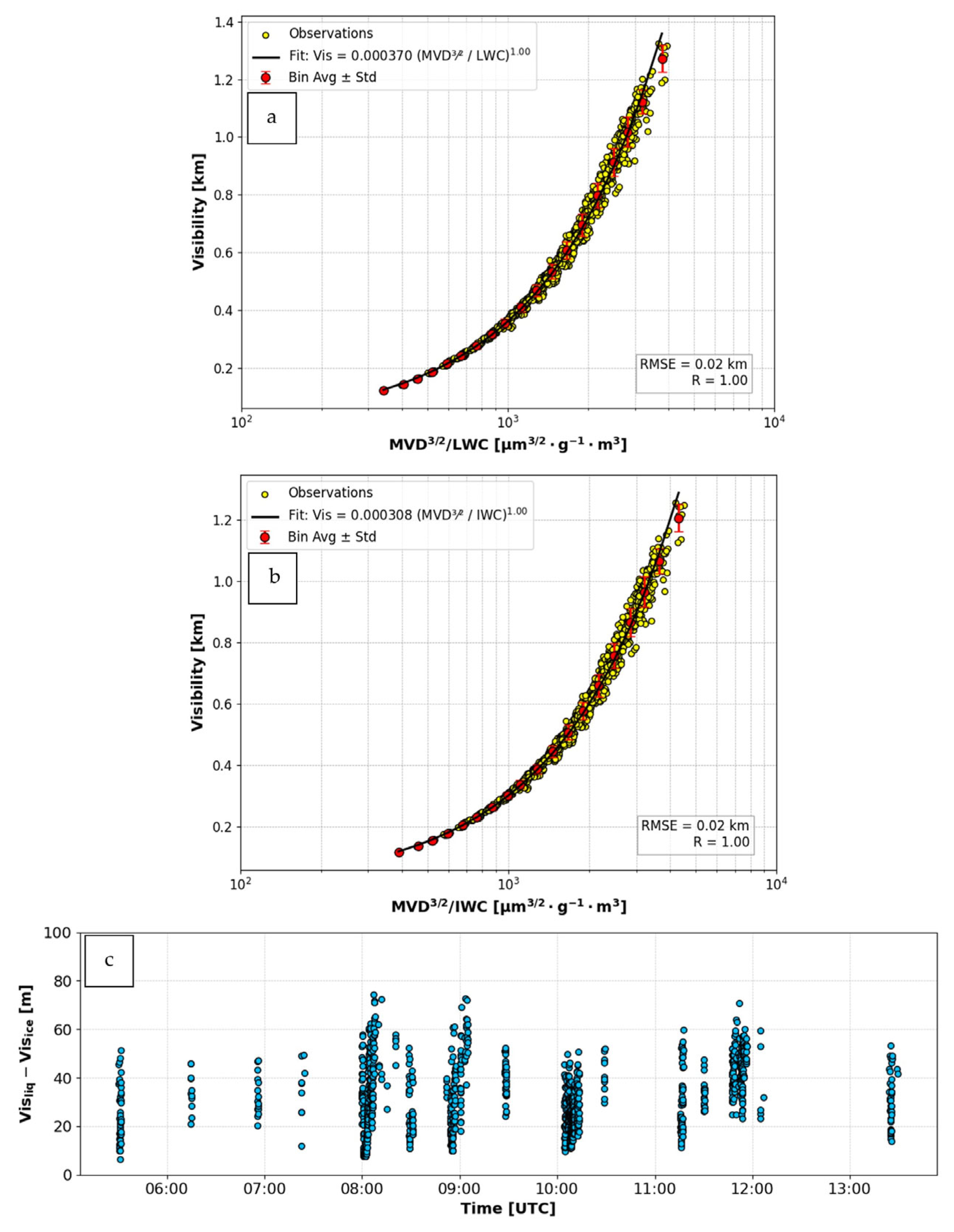
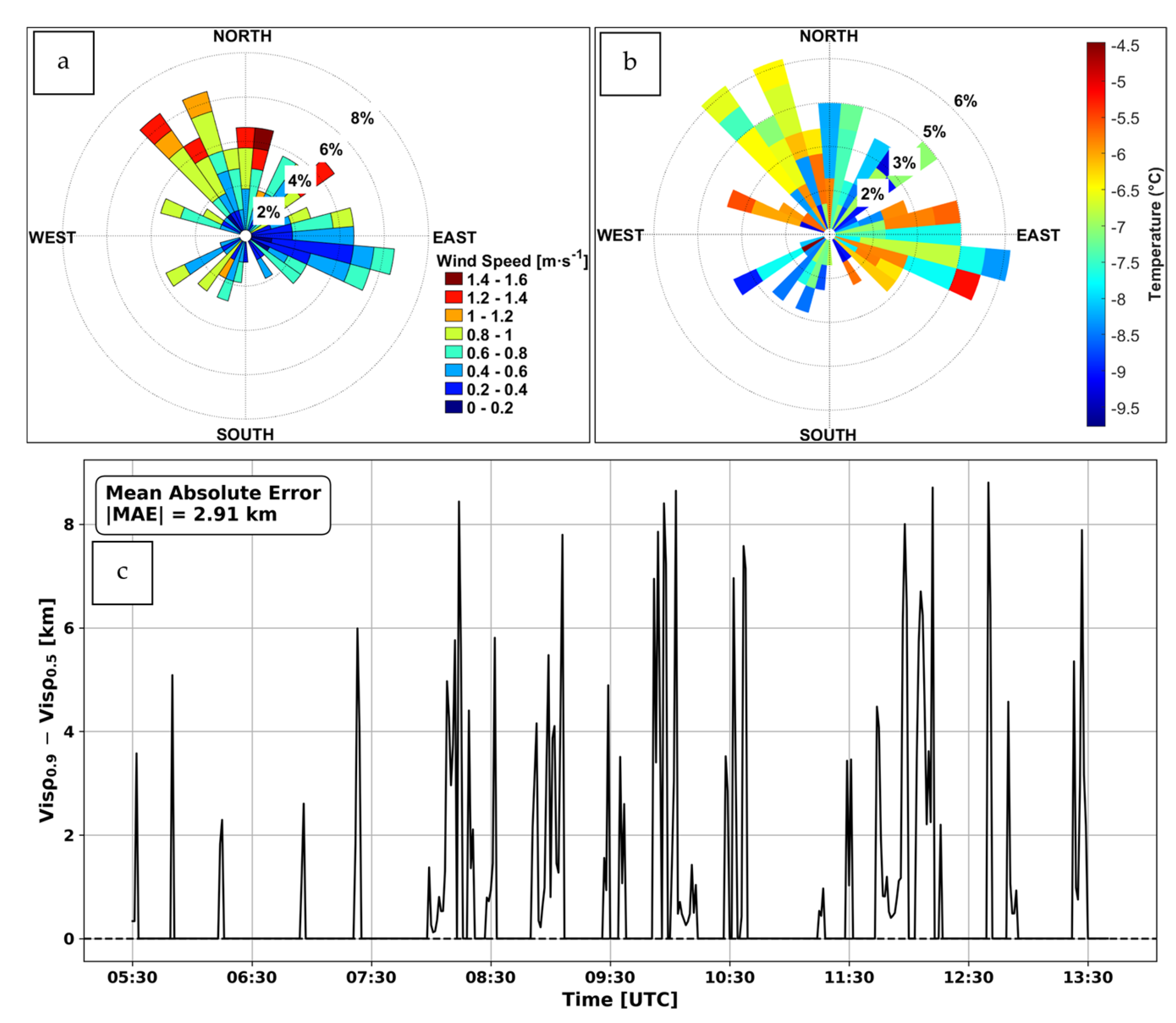


| Site | Lat Lon and Elevation (m, MSL) | Instrument | Measured or Retrieved Parameters | H (a.g.l., m) | Manufacturer |
|---|---|---|---|---|---|
| DC MP | 40.488 320°N 111.468 143°W 1659m | Present Weather Detector (PWD22) | Vis < 20 km and PR (mm/h—10 min interval), Ta | 5 | Vaisala Inc., Vantaa, Finland |
| Celiometer (CL31) | Horizontal looking βh | 1.5 | Vaisala Inc., Vantaa, Finland | ||
| Weather Transmitter (WXT520) | Ta/RH/Uh/dir | 1.5 | Vaisala Inc., Vantaa, Finland | ||
| Cloud particle Spectrometer Fog Monitor (FM120) | Nd, LWC, MVD from Size Distribution (2–50 μm, 30 size bins) | 2 | DMT, Boulder, CO, USA | ||
| Ground-based cloud imaging probe (GCIP) | Cloud particle size distribution (10–1000 μm) | 3 | DMT, Boulder, CO, USA | ||
| DC AT | 40.489 940°N, 111.470 331°W 1661m | Scanning Mobility Particle Sizer (SMPS Model 3938) | Na size distribution in 128 bin (8 nm to 19.81 mm) | 2 | TSI Inc, Minneapolis, MN, USA |
| MiniVol Tactical Air Sampler (MTAS) | (PM10 Filters—smaller than 10 μm) | 2 | Airmetric, Eugene, OR, USA | ||
| DC S | 40.489027°N 111.470164°W 1660 m | Celiometer (CL61) | Vertical looking β and depolarization ratio | 2 | Vaisala Inc., Vantaa, Finland, USA |
| DC FT | 40.490101°N 111.464737°W 1659 m | Broadband Radiometer (CMP21) | 4-component radiation | 2 | Kipp and Zonen, Delft, Netherlands |
| Hygrothermometer (SHT85) | Ta, RH | 2 | Sensirion, Stäfa, Switzerland | ||
| 3D sonic anemometer (CSAT3) | u, v, w, dir | 2 | Campbell Scientific, Logan, UT, USA | ||
| Nanobarometer | P | 2 | Paroscientific Inc., Redmond, WA, USA |
Disclaimer/Publisher’s Note: The statements, opinions and data contained in all publications are solely those of the individual author(s) and contributor(s) and not of MDPI and/or the editor(s). MDPI and/or the editor(s) disclaim responsibility for any injury to people or property resulting from any ideas, methods, instructions or products referred to in the content. |
© 2025 by the authors. Licensee MDPI, Basel, Switzerland. This article is an open access article distributed under the terms and conditions of the Creative Commons Attribution (CC BY) license (https://creativecommons.org/licenses/by/4.0/).
Share and Cite
Durmus, O.; Gultepe, I.; Sen, O.; Pu, Z.; Pardyjak, E.R.; Hoch, S.W.; Perelet, A.; Hallar, A.G.; Carrillo-Cardenas, G.; Durmus, S. Freezing Fog Microphysics and Visibility Based on CFACT Feb 19 Case. Remote Sens. 2025, 17, 2728. https://doi.org/10.3390/rs17152728
Durmus O, Gultepe I, Sen O, Pu Z, Pardyjak ER, Hoch SW, Perelet A, Hallar AG, Carrillo-Cardenas G, Durmus S. Freezing Fog Microphysics and Visibility Based on CFACT Feb 19 Case. Remote Sensing. 2025; 17(15):2728. https://doi.org/10.3390/rs17152728
Chicago/Turabian StyleDurmus, Onur, Ismail Gultepe, Orhan Sen, Zhaoxia Pu, Eric R. Pardyjak, Sebastian W. Hoch, Alexei Perelet, Anna G. Hallar, Gerardo Carrillo-Cardenas, and Simla Durmus. 2025. "Freezing Fog Microphysics and Visibility Based on CFACT Feb 19 Case" Remote Sensing 17, no. 15: 2728. https://doi.org/10.3390/rs17152728
APA StyleDurmus, O., Gultepe, I., Sen, O., Pu, Z., Pardyjak, E. R., Hoch, S. W., Perelet, A., Hallar, A. G., Carrillo-Cardenas, G., & Durmus, S. (2025). Freezing Fog Microphysics and Visibility Based on CFACT Feb 19 Case. Remote Sensing, 17(15), 2728. https://doi.org/10.3390/rs17152728








